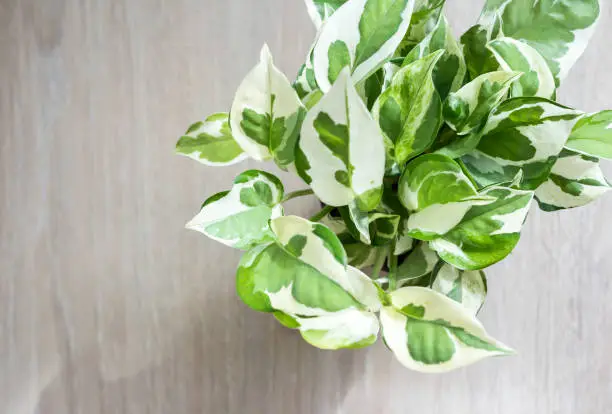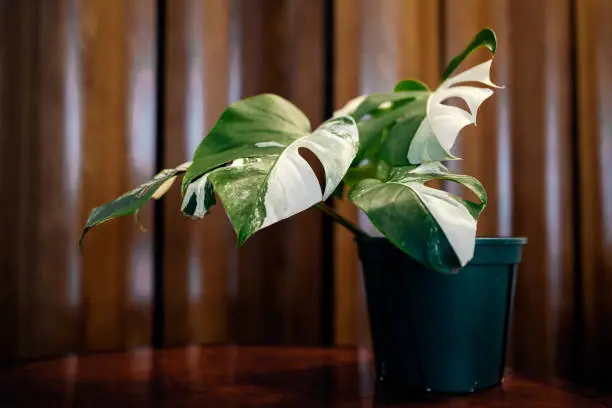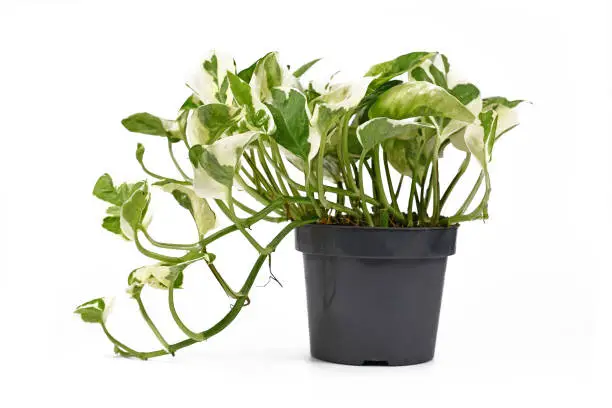The White Princess Philodendron, also known as Philodendron ‘White Princess,’ is a popular type of philodendron plant. It’s known for its unique foliage with variegated patterns, including shades of green, white, and sometimes pink. The leaves typically have a glossy appearance and can develop a slightly pink hue when exposed to bright daylight. However, as you grow Philodendron ‘White Princess,’ remember the delicate balance of care required to maintain its unique beauty. You’ll be rewarded with a successful plant that graces your space’s elegance and energy through careful pruning, vertical recommendation, and the right light conditions.

White princess philodendron plant caring and monitoring
However, it’s important to note that the White Princess Philodendron can be somewhat challenging to manage, especially for beginners. Here are some care tips:
- Light: The White Princess Philodendron plant prefers bright, indirect daylight. Too little light can result in diminished variegation, while too much light can lead to burnt leaves.
- Watering: Allow the top 1-2 Inch of the soil to dry out before watering. Overwatering can lead to root rot, so preventing the plant from drowning to settle down in the bottom is important.
- Humidity: White Princess Philodendrons flourish in humid environments.
- Temperature: They prefer temperatures between 65-80°F (18-27°C). However, avoid exposing the plant to sudden temperature changes. However, avoid placing the plant below 13ºC (55ºF) temperature, as it is not recommended.
- Soil: Well-draining potting mix with organic matter works well for these plants.
- Pruning: Regularly remove any yellow or damaged leaves to maintain the plant’s health. However, will explore the pruning techniques in the following sections.
Consider your specific environment and the size of your plant when caring for your plants. Your White Princess Philodendron care routine adjusts if it appears to be declining. The White Princess may be too demanding for you if you’re new to plant care.
Read: Does Pothos leaves turning yellow? 10+ Reasons and Solutions
Track Plant Calendar for throughout the year
Throughout the year, you want to know how to care for indoor plants. This indoor plant care calendar will help you keep track of the different types of indoor plants you have, as well as the local climate in your area:
| Season | Tasks |
| Spring | – Begin fertilizing every 4-6 weeks |
| – Prune overgrowth and remove dead leaves | |
| Summer | – Increase watering based on plant needs |
| – Ensure proper light shade, consider outdoor light/shade | |
| – Monitor and treat for pests | |
| Fall | – Watch for temperature drops and protect plants |
| – Shift plants indoors from outdoor exposure | |
| Winter | – Lower watering during severe winter days |
| – Maintain humidity levels | |
| – Prune if needed, removing dead parts |
Your local climate and plants’ requirements should be considered when adapting your care. Despite this, observing and adapting are key to successful plant care. You should adjust how you care for your plants based on the way they respond to your care.
Read: Pothos vs. Philodendron: A Head-to-Head Comparison
Leaf Appearance and Features
You’re asking about the appearance and features of leaves on plants. Leaves come in various shapes, sizes, colors, and textures, and their characteristics can vary greatly between plant species. Here are some common leaf features and variations:
Leaf Shape:
Leaves can be heart-shaped, lanceolate (long and narrow), rounded, lobed, and more.
Leaf Arrangement:
Leaves can be arranged opposite, alternate along the stem, or have three or more leaves at each node.
Leaf Color:
Leaves can be shades of green, ranging from light to dark, and they can also have variegated patterns with white, yellow, red, or pink hues.
Leaf Surface:
Some leaves are glossy, while others have a matte or textured surface.

Leaf Growth of Philodendron ‘White Princess’
Young leaves might look different from mature leaves in color, shape, or size.
Maintaining Optimal Variegation in Philodendron ‘White Princess’:
Pruning Tips for Leaf Color Balance
The philodendron ‘White Princess’ is renowned for its beautiful variegated leafage, illustrating a blend of green, white, and sometimes pink hues. However, this plant can exhibit all-white or all-green leaves over time, which could be better for its sustained health. Leaves empty of chlorophyll cannot support the plant, and solid green leaves indicate a reversal to the traits of its parent plants. To uphold the unique variegation, a proactive approach is required.
Read: Types of Philodendron: Exploring Diverse Varieties
Pruning for Variegation Maintenance
When solid white or green leaves emerge, the solution lies in strategic pruning. Trimming the plant back to the last leaf featuring robust variegation is essential. The process involves precision to ensure renewal and restarted energy.
Pruning Technique
- Identify the Node: Locate the small bumps, or nodes, along the stem. Alternatively, cut just 1 Inch below the leaf where it joins the stem.
- Use a Sterilized Blade: Employ a sterilized sharp cutting tool to prevent damage and infection. Avoid crushing the stem during the process.
- Encourage New Growth: You initiate new growth by pruning at nodes or just below leaves. This allows the plant to branch out, promoting the development of fresh leaves with the desired variegation.
The care taken during pruning directly influences the Philodendron ‘White Princess’ plant’s ability to maintain its beautiful variegation. Keeping a balance of green and white leaves contributes to this unique cultivar’s overall health and charm.
Growth tips for Philodendron ‘White Princess’
Vertical Growth Benefits for Enhanced Foliage
Encourage me to grow vertically, and you’ll notice the amazing change in my leaves. Allowing me to extend upward promotes the development of larger and more robust greenery, creating a visually gorgeous display.
Optimal Light for Variegation Preservation
Shield the Philodendron from direct sunlight, which can lead to fading and damage. The right balance of light will help their leaves maintain their deep green and white hue patterns.
White Princess Philodendron Toxicity
Like many other plants in the philodendron family, the Philodendron’ White Princess’ contains calcium oxalate crystals. These crystals can irritate the skin and mucous membranes if in direct contact. The plant is considered quite toxic to humans and other household companion animals.
If swallowed by human or household companions, it can cause symptoms such as:
- Oral disturbance
- Extreme drooling
- Sickness
- Vomiting
If you suspect that someone, including pets, has consumed any part of the plant and is showing symptoms, it’s recommended to seek medical attention or veterinary care if necessary.

If you’re concerned about the potential toxicity of Philodendron ‘White Princess’ in your home, consider placing it in a location inaccessible to pets and small kids.
Additionally, always wash your hands thoroughly after handling the plant to avoid any potential irritation.
Read Philodendron erubescens – Characteristics, Toxicity, and Benefits.
Air-purifying properties of Philodendron ‘White Princess’
The White Princess Philodendron (Philodendron ‘White Princess’) is a popular houseplant known for adoring white-green variegated leaves. While many plants have air-purifying properties, it’s important to note that the extent of these properties and their effectiveness in indoor spaces can vary.
Philodendrons, including the White Princess variety, are not typically considered among the top air-purifying plants. This is because they do not possess the specific adaptations, such as a high surface area of foliage or specialized mechanisms, that some other plants, like snake plants, must actively remove pollutants from the air.
Read: Snake Plant Benefits: A Green Oasis for Health and Wellness
However, like most indoor plants, the White Princess Philodendron can contribute to a healthier indoor environment in some ways:
Increased Humidity
Plants release moisture through transpiration, which can help improve humidity levels in dry indoor spaces.
Psychological Benefits
Surrounding yourself with plants has a positive psychological effect, such as bringing down stress to a considerable amount and increasing well-being. However, the presence of indoor plants like the White Princess can enhance the aesthetic appeal of your living space and contribute to a more pleasant atmosphere.
While the White Princess Philodendron might not be a top choice for air purification, it can still offer a range of benefits regarding potential psychological well-being.
Read: Silver Sword Philodendron – Propagation, Care, and Benefits
If you’re specifically looking for houseplants with strong air-purifying properties, consider exploring other options that have been scientifically studied for their effectiveness in removing indoor pollutants. In some cases, this product can be used to tackle the problem of formaldehyde in indoor spaces. In particular, it effectively eliminates formaldehyde up to 99% from paints, roofing materials, and adhesives[1]Korostenskij, I., Propagation, upkeep, and impact on mental health and classroom/workplace success of Dracaena trifasciata, Chlorophytum comosum, and Philodendron hederaceum. 2021. Read.
Therapeutic properties of White Princess Philodendron
This variety of Philodendron is used as an ornamental house plant because of its variegated leaves. The presence of indoor plants like the White Princess can contribute to a positive and potentially therapeutic environment in various ways. However, it hasn’t traditionally been recognized for specific therapeutic properties.
Lowering Stress
It has been found that being in close proximity to nature and plants eases stress anxiety and promotes relaxation[2]Nainwal, P., Review on Philodendron Species-Plant Seeking For Validation of Its Therapeutic Approaches. J. Pharm. Sci. & Res. Vol. 11(5), 2019, 2003-2006. Read. Caring for and tending to plants can also provide a calming and mindful experience.
Energy Boosting
A White Princess Philodendron can contribute to a more aesthetically pleasing home and improve your mood with its variegated leaves.
Mindfulness and Well-being
Companionship is essential to plant care, which promotes mindfulness and a sense of responsibility. Moreover, Having plants indoors can provide a sense of connection to the natural world.
In spite of its lack of medicinal properties compared to herbs and traditional medicinal plants, the White Princess Philodendron’s presence in your environment can positively influence your psychological and emotional well-being.
Hardiness zone for indoor and outdoor region
USDA Hardiness Zones classify plants according to their suitability for different regions based on average annual minimum temperatures. It helps gardeners select plants most likely to succeed in their specific climate conditions.
Since it cannot tolerate freezing temperatures, its hardiness zone is less relevant when compared to outdoor garden plants [3]Plant Hardiness zone for Indoor Plants. Read.
Indoor and outdoor growth patterns on Hardness
However, if you’re growing it outdoors in warmer regions, you might consider its hardiness zone.
For most indoor plants, including the White Princess Philodendron, their hardiness zones are not commonly referenced, as they are primarily grown indoors where climate conditions are controlled. Your home’s humidity, temperature, and light will have a much more significant impact on their growth and health.
White princess philodendron propagation methods
You can then choose one of the following options to propagate the White Princess Philodendron:
Propagating Philodendron in Water
Place the cutting in a glass jar or water vase, submerging the node well. Change the water every few days to prevent rooting from the rot. However, once the roots are a few inches long, you can re-plant the cutting into the soil.

Propagating White Princess Philodendron in Soil
Plant the cut end of the stem in a well-draining potting mix after soaking it in a rooting hormone. However, maintain the soil is always damp but not soggy. However, place a plastic bag over the cutting to create a humid environment, which aids in root development.
Conclusion
In conclusion, nurturing the growth of Philodendron ‘White Princess’ involves a strategic approach to maximize its visual appeal and energy. However, by encouraging vertical growth, you’ll notice the remarkable modification of its leaves into larger, more unique leafage. Remember that providing bright, indirect daylight is critical for maintaining the beautiful white-green variegation that defines this plant.
References
| ↑1 | Korostenskij, I., Propagation, upkeep, and impact on mental health and classroom/workplace success of Dracaena trifasciata, Chlorophytum comosum, and Philodendron hederaceum. 2021. Read |
|---|---|
| ↑2 | Nainwal, P., Review on Philodendron Species-Plant Seeking For Validation of Its Therapeutic Approaches. J. Pharm. Sci. & Res. Vol. 11(5), 2019, 2003-2006. Read |
| ↑3 | Plant Hardiness zone for Indoor Plants. Read |



